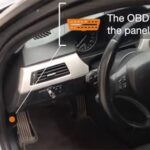The LAUNCH Creader CRP129 OBD2 Scanner Auto Code Reader is engineered to elevate your vehicle diagnostics experience. This professional-grade scan tool extends beyond basic OBDII functionality, offering enhanced OEM-level features that empower both DIY enthusiasts and seasoned mechanics. Equipped with capabilities like Electronic Parking Brake (EPB) release, Steering Angle Reset, and Service Reminder Reset, the CRP129 stands out in its category. Furthermore, it provides comprehensive live PID data graphing for Engine, Transmission, ABS, and SRS systems, ensuring in-depth analysis and accurate diagnoses. Experience rapid boot-up times, manufacturer-specific code definitions, and practical DTC troubleshooter tips, all within a user-friendly interface. Stay current with free internet updates and easily print diagnostic reports via PC, making the Launch CRP129 an indispensable tool in your automotive toolkit.
Unlock Comprehensive Vehicle Diagnostics with LAUNCH CRP129
The Launch CRP129 is not just an OBD2 scanner; it’s a multifaceted diagnostic tool designed to address a wide spectrum of vehicle issues. Going beyond standard OBDII functions, this scanner delves into the four primary systems of your vehicle: Engine, Transmission, ABS, and Airbag (SRS). This expanded capability allows you to pinpoint problems that generic scanners might miss, saving you time and potentially costly repairs. Whether you are facing a perplexing check engine light, transmission glitches, ABS malfunctions, or SRS warning lights, the CRP129 provides the diagnostic depth needed to understand and resolve these issues effectively.
Key Features that Set the CRP129 Apart
What makes the Launch CRP129 a superior choice? It’s the integration of advanced features typically found in higher-priced professional scan tools. Notably, the inclusion of Electronic Parking Brake (EPB) release, Steering Angle Reset, and Service Reminder Reset functions positions the CRP129 as a leader in its price range. These features are crucial for modern vehicle maintenance, allowing for tasks such as brake pad replacement, steering alignment, and oil change resets to be performed with confidence. Coupled with its ability to display and graph live PID data for critical systems, the CRP129 offers a level of diagnostic insight that empowers users to tackle complex automotive issues.
Applications and Benefits of the LAUNCH CRP129
The LAUNCH CRP129 is versatile and beneficial for a range of users. For car owners, it provides the ability to understand and address common vehicle problems, potentially avoiding expensive trips to the mechanic for simple issues. DIY mechanics will appreciate the advanced functions and in-depth diagnostics, making more complex repairs accessible. Entry-level technicians will find the CRP129 to be a cost-effective yet powerful tool for daily diagnostics in a professional setting. The scanner excels in diagnosing issues within the engine, transmission, SRS, and ABS systems, offering not only DTC reading and clearing but also providing code definitions and probable causes directly on the tool. This immediate access to information streamlines the diagnostic process and enhances repair accuracy.
LAUNCH CRP129 Parameters: Designed for Durability and Performance
Built to withstand the demands of automotive environments, the Launch CRP129 features a robust design and user-friendly parameters. Its 3.5-inch screen provides clear and easy-to-read diagnostic data. Operating within a voltage input range of 9-15V and utilizing a standard 16PIN OBD Diagnostic Interface, it ensures compatibility with a wide range of vehicles. Designed to perform in temperatures from 0-55℃ (32-131℉) and store reliably from -20 -70℃ (-4-158℉), the CRP129 is built for dependable operation in various conditions.
Package Contents: Everything You Need to Get Started
The LAUNCH Creader CRP129 package is comprehensive, ensuring you have everything required to begin diagnosing vehicles immediately. The package includes:
- 1pc x LAUNCH Creader CRP129 unit
- 1pc x Diagnostic OBDII Cable
- 1pc x USB Charging Cable
- 1pc x User Manual (U disk)
With its extensive features, user-friendly design, and comprehensive system coverage, the Launch Crp129 Obd2 Scanner Auto Code Reader is an invaluable tool for anyone looking to effectively diagnose and maintain their vehicle.
